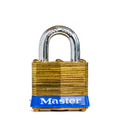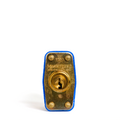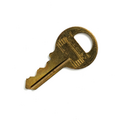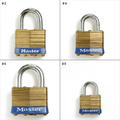Master Lock No 4: Difference between revisions
mNo edit summary |
mNo edit summary |
||
| (5 intermediate revisions by one other user not shown) | |||
| Line 1: | Line 1: | ||
= | <span style="font-size: 188%; line-height:190%">{{PAGENAME}}</span> | ||
---- | |||
{{Lock model | {{Lock model | ||
| name = Master Lock No. 4 | | name = Master Lock No. 4 | ||
| Img = File: | | Img = File:Master Lock No 4 front - FXE48772.png | ||
| Img_size = | | Img_size = 200px | ||
| maker = [[Master Lock]] | | maker = [[Master Lock]] | ||
| lock_type = [[Padlock]], [[Cylinder]] | | lock_type = [[Padlock]], [[Cylinder]] | ||
| Line 18: | Line 19: | ||
The '''No. 4''' is a [[Pin_tumbler|pin-tumbler]] [[padlock]] made by [[Master Lock]]. The No. 4 uses a laminated brass padlock body with an internal key-in-knob-style [[cylinder]]. The inner cylinder uses four pin stacks and does not use any [[security pin]]s. | The '''No. 4''' is a [[Pin_tumbler|pin-tumbler]] [[padlock]] made by [[Master Lock]]. The No. 4 uses a laminated brass padlock body with an internal key-in-knob-style [[cylinder]]. The inner cylinder uses four pin stacks and does not use any [[security pin]]s. | ||
The No. 4 is a common low security padlock used in the United States. | The No. 4 is a common low security padlock used in the United States. It is one of a line of laminated brass padlocks that includes the [[Master Lock No 2|Master Lock #2]], [[Master Lock No 4|#4]], [[Master Lock No 6|#6]], and [[Master Lock No 8|#8]]. | ||
__TOC__ | __TOC__ | ||
| Line 24: | Line 25: | ||
== Principles of operation == | == Principles of operation == | ||
:''See also [[Pin tumbler#Principles of operation|Pin-tumbler (Principles of Operation)]]'' | |||
The No. 4 cylinder is a [[Pin_tumbler|pin-tumbler]] lock with four pin stacks and no [[security pin]]s. The cylinder typically uses the [[M1]] [[Key#Types_of_Keys|key profile]] but may use other profiles, as well. The standard No. 4 can be opened in both directions but the "commercial" series body restricts opening to clockwise rotation. The No. 4 is not a [[key retaining]] padlock. | The No. 4 cylinder is a [[Pin_tumbler|pin-tumbler]] lock with four pin stacks and no [[security pin]]s. The cylinder typically uses the [[M1]] [[Key#Types_of_Keys|key profile]] but may use other profiles, as well. The standard No. 4 can be opened in both directions but the "commercial" series body restricts opening to clockwise rotation. The No. 4 is not a [[key retaining]] padlock. | ||
| Line 49: | Line 52: | ||
== Gallery == | == Gallery == | ||
<div align="center"><gallery align="center"> | |||
File:Master Lock No 4 front - FXE48772.png | Front | |||
File:Master Lock No 4 keyway - FXE48774.png | Keyway | |||
File:Master Lock No 4 key - FXE48747.png | Key | |||
File:Master Lock No 2-8 grid - FXE48731-Edit.png | ML #2, #4, #6, and #8. | |||
</gallery></div> | |||
== See also == | == See also == | ||
Latest revision as of 16:19, 21 August 2025
Master Lock No 4
| Master Lock No. 4 | |
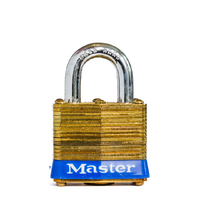 | |
| Name | Master Lock No. 4 |
|---|---|
| Manufacturer | Master Lock |
| Lock Type | Padlock, Cylinder |
| Lock Design | Pin-tumbler |
| Specifications | |
| # of Components | 4 |
| Component Type | Pin-tumbler |
The No. 4 is a pin-tumbler padlock made by Master Lock. The No. 4 uses a laminated brass padlock body with an internal key-in-knob-style cylinder. The inner cylinder uses four pin stacks and does not use any security pins.
The No. 4 is a common low security padlock used in the United States. It is one of a line of laminated brass padlocks that includes the Master Lock #2, #4, #6, and #8.
Principles of operation
The No. 4 cylinder is a pin-tumbler lock with four pin stacks and no security pins. The cylinder typically uses the M1 key profile but may use other profiles, as well. The standard No. 4 can be opened in both directions but the "commercial" series body restricts opening to clockwise rotation. The No. 4 is not a key retaining padlock.
Disassembly instructions
The No. 4 cannot be disassembled non-destructively. To disassemble it the rivets that hold the laminated body together must be removed and each layer removed individually. The inner cylinder itself can be disassembled in the same manner as a traditional pin-tumbler lock:
- Remove the cam or C-clip.
- Insert the key and turn the plug 45-90 degrees.
- Withdraw the plug from the cylinder. (A plug follower is recommended)
OR
- Remove the chamber casings and take out each pin-stack individually
- Remove the cam or C-clip.
- Withdraw the plug from the cylinder.
Notes
- The No. 4 cylinder requires a small diameter plug follower.
- The No. 4 plug is retained by a crimp, rather than a C-clip or cam. Above are the generic pin-tumbler disassembly instructions.
Vulnerabilities
The No. 4 is vulnerable to a wide range of attacks. The reduced pin tumbler count and poor manufacturing tolerances makes it an easy lock to pick. It's commonly given to locksport beginners as a "confidence lock"; a lock that is easy to open and inspires you to continue picking. The No. 4 may be vulnerable to one or more of the following:
